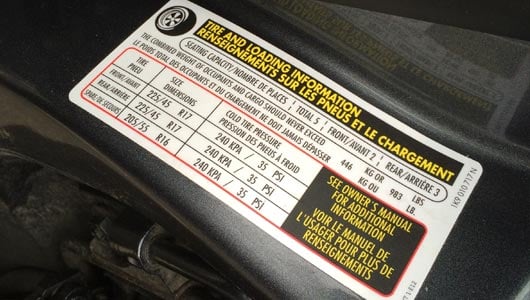The recommended tire pressure for your vehicle is usually found in the owner’s manual or on a sticker inside the driver’s door. It varies by vehicle make and model.
Maintaining the correct tire pressure is crucial for safety and performance. Properly inflated tires ensure optimal contact with the road, improving handling and fuel efficiency. Under-inflated or over-inflated tires can lead to uneven wear, reduced traction, and even blowouts. Regularly check your tire pressure using a reliable gauge.
It’s best to do this when the tires are cold, as heat can affect the readings. Adhering to the manufacturer’s recommended tire pressure can extend the lifespan of your tires and enhance your driving experience. Always consult your vehicle’s manual for specific guidelines.
Importance Of Proper Tire Pressure
Proper tire pressure keeps you safe on the road. Under-inflated tires can cause accidents. Over-inflated tires can burst while driving. Always check your tire pressure regularly. This prevents unexpected issues.
Correct tire pressure can save you money on gas. Under-inflated tires make your car use more fuel. Over-inflated tires wear out faster. Keep your tires at the right pressure. This helps your car run smoothly.

Finding The Right Tire Pressure
Check the owner’s manual for tire pressure. The manual provides recommended PSI. This information is crucial for safety. It helps with fuel efficiency and tire longevity.
Look at the tire sidewall for pressure details. You will see a maximum PSI listed. Do not exceed this number. It can be dangerous.
How To Check Tire Pressure
Use a tire gauge to check the pressure. First, remove the valve cap from the tire. Press the tire gauge onto the valve stem. The gauge will show the pressure. Compare this reading to the recommended pressure. If the pressure is low, add air. If it is high, release some air.
Check tire pressure when the tires are cold. This means after the car has been parked for a few hours. It is best to check in the morning. Always check before a long trip. Make sure to check at least once a month.

Adjusting Tire Pressure
Check the tire pressure with a tire gauge. Find the recommended pressure in your car manual. Attach the air hose to the tire valve. Add air until the gauge shows the right pressure. Always recheck the pressure after inflating. Avoid over-inflating your tires as it can be dangerous. Proper inflation improves fuel efficiency and safety. Keep a tire gauge in your car for emergencies.
Check the tire pressure with a tire gauge. Locate the valve stem on your tire. Press the metal pin inside the valve with a small tool. Let air out until you reach the correct pressure. Recheck the tire pressure to ensure accuracy. Do not deflate tires too much. Under-inflation can lead to poor handling. Proper tire pressure ensures a smoother ride and better control.
Seasonal Tire Pressure Variations
Cold weather can lower your tire pressure. Cold air makes the tire pressure drop. Check your tire pressure often in winter. Add air if the tire pressure is low. Tires need to be properly inflated to keep you safe. Low tire pressure can cause accidents.
Hot weather can increase tire pressure. Hot air makes the tire pressure rise. Check your tire pressure often in summer. Let some air out if the tire pressure is too high. Overinflated tires can also cause accidents. Keep your tires at the right pressure for safety.
Effects Of Incorrect Tire Pressure
Under-inflated tires can cause many problems. They can wear out faster and unevenly. This reduces the lifespan of the tire. Fuel efficiency drops because the engine works harder. The vehicle may also handle poorly, increasing the risk of accidents. Heat builds up in the tire, which can lead to a blowout. This is very dangerous, especially at high speeds.
Over-inflated tires make less contact with the road. This reduces traction and can make the ride very bumpy. Tires wear out in the center more quickly. This shortens their lifespan. The risk of a blowout also increases because the tire is stretched too thin. Over-inflation can also damage the suspension of the vehicle.
Technology And Tire Pressure
Many cars have Tire Pressure Monitoring Systems (TPMS). These systems alert drivers when tire pressure is too low. They use sensors inside the tires. These sensors send data to the car’s computer. Drivers can then see tire pressure on their dashboard. This helps in keeping tires at the right pressure.
New smart tires can adjust pressure automatically. These tires have built-in technology. They can sense road conditions. They can change pressure to give the best grip. This makes driving safer and more comfortable. Smart tires help save fuel and reduce wear.

Maintaining Optimal Tire Pressure
Check your tire pressure every month. Use a reliable tire gauge. Always measure tire pressure when tires are cold. Follow the recommended tire pressure in your vehicle’s manual. Inflate tires to the correct pressure. This helps improve fuel efficiency. It also ensures better handling and safety. Do not forget the spare tire. It needs proper pressure too. Rotate your tires every 6,000 to 8,000 miles. This helps them wear evenly. Look for any visible damage. Replace damaged tires immediately.
Many people believe over-inflating tires improves fuel economy. This is not true. Over-inflating tires can be dangerous. It may cause uneven tire wear. Some think under-inflating provides better traction. This is also false. Under-inflating tires can lead to tire failure. Always stick to the recommended tire pressure. Another myth is that new tires do not need checking. All tires need regular pressure checks. Do not rely on visual inspection alone. Always use a tire gauge to confirm tire pressure.
Frequently Asked Questions
What Is The Ideal Tire Pressure For My Car?
The ideal tire pressure varies by vehicle. Check the manufacturer’s recommendation in your owner’s manual or the sticker inside the driver’s door.
How Often Should I Check My Tire Pressure?
Check your tire pressure at least once a month. Regular checks ensure optimal performance and safety.
Can Tire Pressure Affect Fuel Efficiency?
Yes, proper tire pressure improves fuel efficiency. Underinflated tires can decrease mileage and increase fuel consumption.
What Happens If My Tire Pressure Is Too Low?
Low tire pressure can cause poor handling, reduced fuel efficiency, and increased tire wear. It may also lead to blowouts.
Conclusion
Maintaining the correct tire pressure ensures safety and efficiency. Regularly check your vehicle’s manual for recommendations. Proper tire pressure can improve fuel efficiency and extend tire life. Don’t overlook this simple, yet crucial, aspect of vehicle maintenance. Keep your tires properly inflated for a smoother and safer driving experience.












